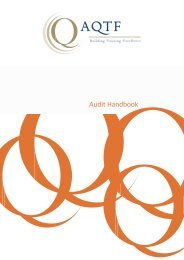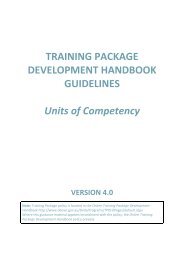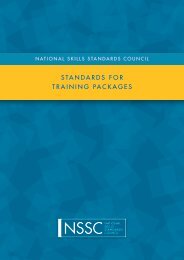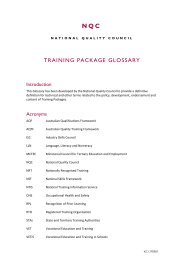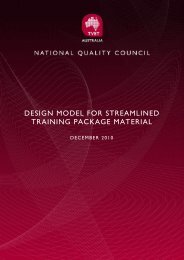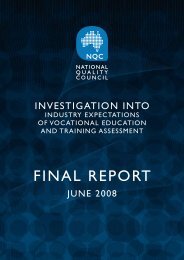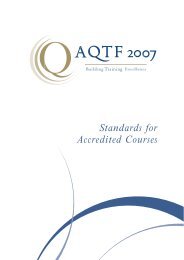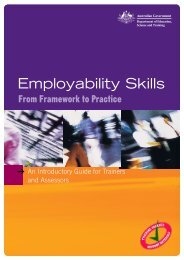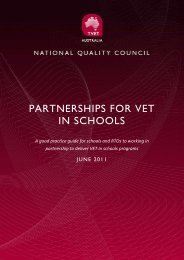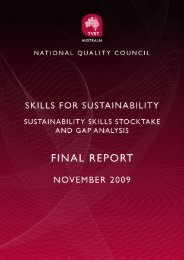VET Products for the 21st Century - National Skills Standards Council
VET Products for the 21st Century - National Skills Standards Council
VET Products for the 21st Century - National Skills Standards Council
Create successful ePaper yourself
Turn your PDF publications into a flip-book with our unique Google optimized e-Paper software.
Students in remote localities face particularchallenges in being able to access training andworkplaces. There is also an important and growinginterface between <strong>for</strong>mal <strong>VET</strong> and communitybasededucation and training providers.It should be recognised that regardless of <strong>the</strong>irlearning pathway, <strong>the</strong> vast majority of students areengaged in <strong>VET</strong> <strong>for</strong> vocational and work relatedpurposes. However, some people work in <strong>the</strong>occupations <strong>for</strong> which <strong>the</strong>y have not trained ando<strong>the</strong>rs work in occupations <strong>for</strong> which <strong>the</strong>y do nothave relevant <strong>for</strong>mal qualifications 7 . This suggeststhat <strong>the</strong> ability to learn ‘on <strong>the</strong> job’ and <strong>the</strong> capacityto adapt to new job roles and circumstances isimportant <strong>for</strong> individuals and <strong>the</strong> work<strong>for</strong>cegenerally.These imperatives suggest <strong>the</strong> following threemajor roles <strong>for</strong> <strong>VET</strong> in assisting to meet <strong>the</strong> COAGoutcomes:• building sound foundation skills, in particularliteracy and numeracy at levels required <strong>for</strong>effective participation in <strong>the</strong> work<strong>for</strong>ce and <strong>for</strong>fur<strong>the</strong>r learning;• developing technical and occupational skillsrequired <strong>for</strong> specific jobs; and• developing <strong>the</strong> wider range of broadercapabilities required <strong>for</strong> specific jobs and <strong>the</strong>capacity to take on new roles and jobs as <strong>the</strong>labour market changes.It is <strong>the</strong>re<strong>for</strong>e proposed that <strong>the</strong> definition ofcompetence be revised to make explicit <strong>the</strong> factthat competence needs to embody <strong>the</strong> ability totransfer and apply skills and knowledge to newsituations and environments and that <strong>VET</strong>qualifications allow <strong>for</strong> both occupational andfoundation skills outcomes.4 . 3 E q u i t y c o n s i d e r a t i o n sThe <strong>VET</strong> system is a key mechanism <strong>for</strong> delivering<strong>the</strong> nation’s productivity, work<strong>for</strong>ce participationand social inclusion objectives. Yet, <strong>the</strong> <strong>National</strong><strong>VET</strong> Advisory Alliance in its final report to Ministers(2008) noted that:Annual <strong>National</strong> Report per<strong>for</strong>mancemeasures (2006) <strong>for</strong> female students,people with a disability, those with alanguage background o<strong>the</strong>r than Englishand Indigenous students, indicate a lackof progress particularly <strong>for</strong> Indigenousstudents and students with disabilities in<strong>the</strong> <strong>VET</strong> system. 8Additionally, <strong>the</strong>y advised that:• Over a four-year period (2003-2006), relative to all students, <strong>the</strong>re had been little improvement in <strong>the</strong> proportion of students in <strong>the</strong> four equity groups participating in <strong>VET</strong>.• Over <strong>the</strong> four-year period, <strong>the</strong>re had only beena marginal increase in <strong>the</strong> load pass rate <strong>for</strong>Indigenous students, students with a disabilityand people who speak a language o<strong>the</strong>r thanEnglish at home. Women’s load pass ratesare at <strong>the</strong> same level as <strong>the</strong> overall <strong>VET</strong>student population.• In 2006, people with a disability were muchless likely than any o<strong>the</strong>r student group to bestudying at Certificate III and above courselevels. Indigenous students were alsounderrepresented at <strong>the</strong>se levels and overrepresentedat Certificate I and II or non AQTFlevels. This is of concern since Certificate Iand II level and non-AQTF level courses areless likely to lead to employment.• While <strong>the</strong>re had been a decline in fur<strong>the</strong>rstudy and employment outcomes <strong>for</strong> all <strong>VET</strong>students over <strong>the</strong> four-year period, <strong>the</strong> declineis much worse <strong>for</strong> <strong>the</strong> four equity groups. ForIndigenous Australians and people with adisability who in 2006 were 14% and 22%respectively below o<strong>the</strong>r students inemployment outcomes, <strong>the</strong> falling trend over 4years is of major concern. 9In <strong>the</strong> face of <strong>the</strong>se per<strong>for</strong>mance outcomes, it iscritical that a revitalised policy framework <strong>for</strong> <strong>VET</strong><strong>Products</strong> <strong>for</strong> <strong>the</strong> 21 st <strong>Century</strong> caters <strong>for</strong> <strong>the</strong> diversityof learners it must engage, if <strong>the</strong> <strong>VET</strong> sector is tomeet national participation and productivity targetsand ensure that it maintains its strong reputation ofmaking a difference to <strong>the</strong> lives of those whostruggle to learn or work. In particular, trainingproducts and services of <strong>the</strong> <strong>VET</strong> sector must besufficiently flexible to cater <strong>for</strong> learners whose lifeexperiences, capacities, motivations, resources andneed <strong>for</strong> particular educational and o<strong>the</strong>r supportsare incredibly diverse, complex and in some cases,expensive.Given <strong>the</strong> <strong>VET</strong> system’s central role in meetingequity inclusivity goals and <strong>the</strong> imminentestablishment of <strong>the</strong> <strong>National</strong> <strong>VET</strong> Equity Advisory<strong>Council</strong> (NVEAC), it will be critical <strong>for</strong> <strong>the</strong> NQC andNVEAC to jointly conduct a review on how best toensure that equity needs are addressed.7The 2008 student outcomes data from NCVER indicatesthat ‘Overall, 30.3% of graduates were employed in <strong>the</strong> sameoccupation group as <strong>the</strong>ir training course. Ano<strong>the</strong>r 33.8%were employed in o<strong>the</strong>r occupations but found <strong>the</strong>ir trainingrelevant. 16.8% were employed in o<strong>the</strong>r occupations andfound <strong>the</strong>ir training not relevant to <strong>the</strong>ir current job’.8<strong>National</strong> <strong>VET</strong> Advisory Alliance final report, unpublished, p49<strong>National</strong> <strong>VET</strong> Advisory Alliance final report, unpublished, p5<strong>VET</strong> PRODUCTS FOR THE 21 ST CENTURY - 11



